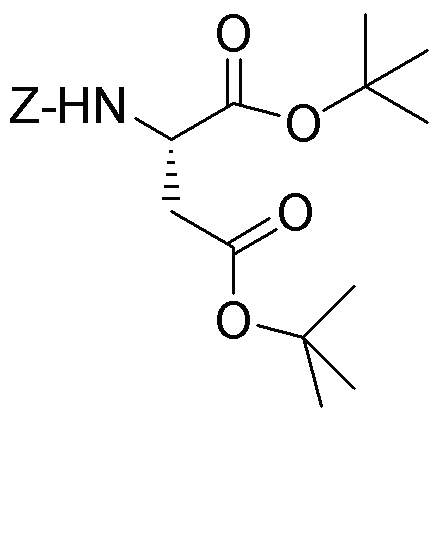Z-L-aspartic acid-di-tert-butyl ester is widely utilized in research focused on:
- Synthesis of Peptides: This compound serves as a key intermediate in the synthesis of various peptides, enabling researchers to develop new therapeutic agents.
- Drug Development: It is used in pharmaceutical research to create prodrugs that enhance the bioavailability of active pharmaceutical ingredients.
- Biochemical Studies: The compound is valuable in studying enzyme mechanisms and protein interactions, providing insights into biological processes.
- Polymer Chemistry: It finds applications in the development of novel polymers, contributing to advancements in materials science.
- Food Industry: The compound can be utilized in flavor enhancement and food preservation, offering potential benefits in food technology.
General Information
Properties
Safety and Regulations
Applications
Z-L-aspartic acid-di-tert-butyl ester is widely utilized in research focused on:
- Synthesis of Peptides: This compound serves as a key intermediate in the synthesis of various peptides, enabling researchers to develop new therapeutic agents.
- Drug Development: It is used in pharmaceutical research to create prodrugs that enhance the bioavailability of active pharmaceutical ingredients.
- Biochemical Studies: The compound is valuable in studying enzyme mechanisms and protein interactions, providing insights into biological processes.
- Polymer Chemistry: It finds applications in the development of novel polymers, contributing to advancements in materials science.
- Food Industry: The compound can be utilized in flavor enhancement and food preservation, offering potential benefits in food technology.
Documents
Safety Data Sheets (SDS)
The SDS provides comprehensive safety information on handling, storage, and disposal of the product.
Product Specification (PS)
The PS provides a comprehensive breakdown of the product’s properties, including chemical composition, physical state, purity, and storage requirements. It also details acceptable quality ranges and the product's intended applications.
Certificates of Analysis (COA)
Search for Certificates of Analysis (COA) by entering the products Lot Number. Lot and Batch Numbers can be found on a product’s label following the words ‘Lot’ or ‘Batch’.
*Catalog Number
*Lot Number
Certificates Of Origin (COO)
This COO confirms the country where the product was manufactured, and also details the materials and components used in it and whether it is derived from natural, synthetic, or other specific sources. This certificate may be required for customs, trade, and regulatory compliance.
*Catalog Number
*Lot Number
Safety Data Sheets (SDS)
The SDS provides comprehensive safety information on handling, storage, and disposal of the product.
DownloadProduct Specification (PS)
The PS provides a comprehensive breakdown of the product’s properties, including chemical composition, physical state, purity, and storage requirements. It also details acceptable quality ranges and the product's intended applications.
DownloadCertificates of Analysis (COA)
Search for Certificates of Analysis (COA) by entering the products Lot Number. Lot and Batch Numbers can be found on a product’s label following the words ‘Lot’ or ‘Batch’.
*Catalog Number
*Lot Number
Certificates Of Origin (COO)
This COO confirms the country where the product was manufactured, and also details the materials and components used in it and whether it is derived from natural, synthetic, or other specific sources. This certificate may be required for customs, trade, and regulatory compliance.


